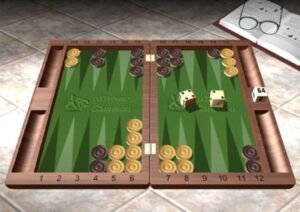Cash game, center cube.

White to play 4-2.
If you understood the logic behind our last problem, you should have no trouble with this one, although the two positions belong to different categories. Our last problem was what I call a ‘One Man Back’ position, where the issue was to move up in the board and try to get into a race, or stay back and wait for a better chance later. This position belongs in a category I call ‘Split or Something Else’, where one choice is to split the back checkers and go for an anchor, while the other choice is something different, like making an offensive point, bringing down builders, or just waiting. In this case Play A is splitting with 24/20 13/11, while Play B is to wait with 13/7, gobbling up some of White’s timing in the process.
The merits of the two plays seem pretty clear. Splitting looks like the high risk, high reward play, while staying back maintains the status quo while waiting for a better chance to move up.
The key question you need to ask in these positions is a simple one: If I move up and get pointed on, how much worse off am I than if I had stayed back and Black had made the point anyway? In our last problem, we saw that getting pointed on was hardly any worse at all than staying back and having Black make the point. Is that true in this position as well?
Actually, the result here is even more surprising. If, for instance, White knew that Black’s next roll would be 6-2, making the 5-point, White would still be better off splitting! This seems startlingly counter-intuitive to most players, but if we drill down into some of the variations, we can see the logic.
1) After Black makes his 5-point, the only great rolls for White are those which let him anchor on Black’s 4-point. If White has two checkers back on the 24-point, only one number accomplishes this (3-3). If White has a checker on the bar, he can make Black’s 4-point with two numbers (4-3 and 3-4).
2) White’s big numbers (6-6, 5-5, and 6-5) are very bad if White has to play them while sitting on the 24-point, since they ruin his timing. If White is in the air, however, he dances with these numbers, which improves his position considerably. Remember that White’s 4-prime is a huge asset in this position (his only asset, in fact), and once that goes he’s toast.
3) Once Black makes the 5-point, White needs to be advancing to Black’s 4-point. He has more ways to get to the 4-point if he’s on the bar (all fours plus 2-3, 1-3, and 2-2) than if both checkers are on the 24-point (all threes plus 1-2).
If we then do a rollout in Extreme Gammon, we get results that confirm these ideas. After White plays 13/7 and Black rolls 6-2, White (on roll) is about 30% to win, while after White plays instead 24/20 13/11 followed by a 6-2 from Black, White is about 34% to win! By splitting, White isn’t actually taking on extra risk for a big reward. The play is essentially risk-free, since it’s both trying to establish an anchor while preserving timing on the other side of the board. In this sense the play has a connection to a lot of back game situations, where the back game player can leave blots freely, knowing that he’s better off both when the blots get hit and when they don’t get hit.
The last point to notice about the position is the cube action. It’s no double and easy take after either play. White’s 4-point prime is a huge asset, giving Black plenty of work to do on both sides of the board.





